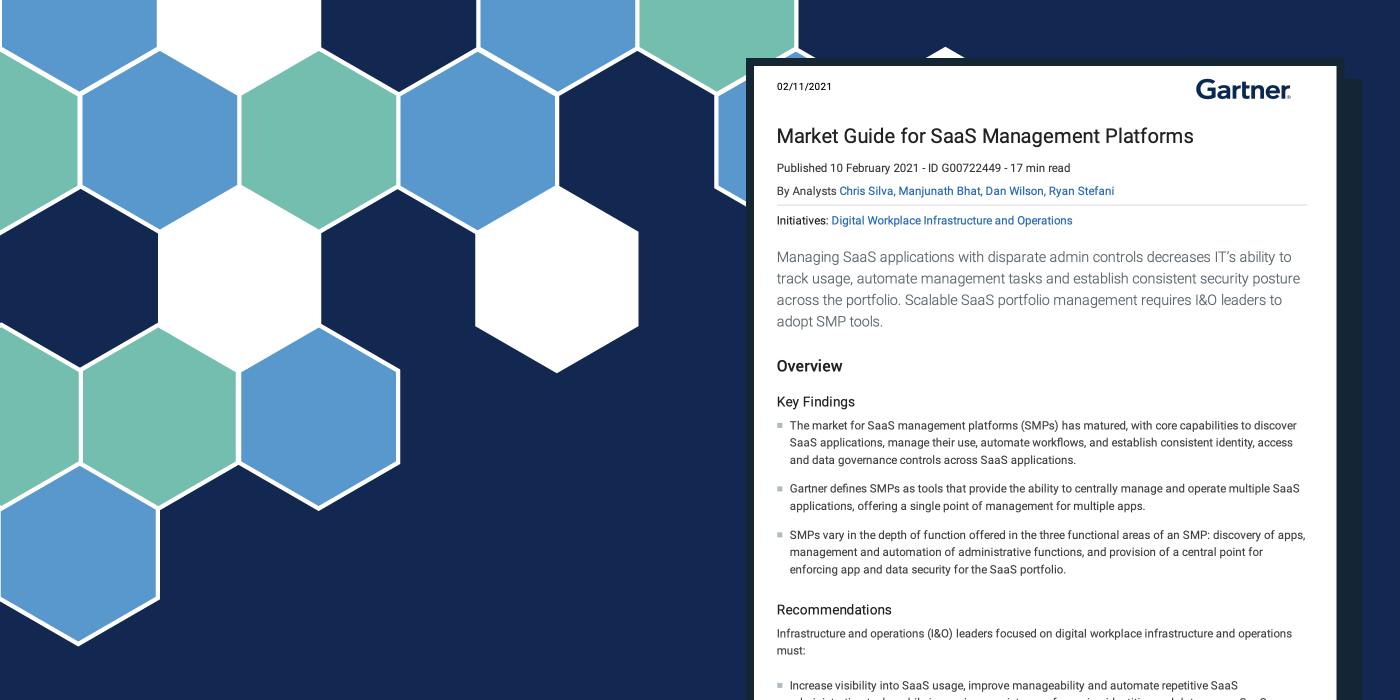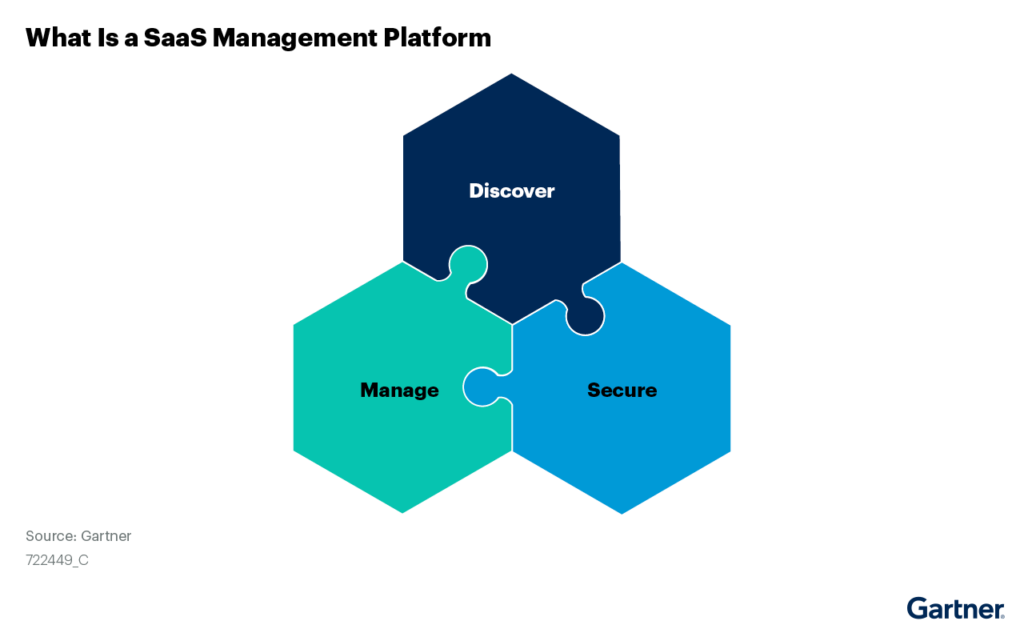Gartner Market Guide for SaaS Management Platforms 2021: Discover, Manage & Secure Your SaaS Apps
February 16, 2021
6 minute read

Last week, Gartner published the 2021 edition of its Market Guide for SaaS Management Platforms (SMPs). In this report, “Gartner defines SMPs as stand-alone tools that can discover, manage, and secure multiple SaaS applications from a central admin dashboard, delivered as a turnkey service.”
As the pioneer of the SMP category, we at BetterCloud could not be more thrilled about the alignment of our vision to Gartner’s category definition!

For a complimentary copy of the report, click here.
Here’s our full analysis and key takeaways from the report:
Market evolution
At the outset, Gartner calls out that since its last edition of the report in 2018, “The market for SMPs has matured, with core capabilities to discover SaaS applications, manage their use, automate workflows, and establish consistent identity, access and data governance controls across SaaS applications.”
“By 2026, 50% of organizations using multiple SaaS applications will centralize management and usage metrics of these apps using an SMP tool, an increase from less than 20% in 2021.”
Gartner says that this upward trend in the market is “influenced by the growth in procurement and consumption of SaaS applications due to remote and hybrid work; Gartner has observed a shift toward multi-SaaS management in tools . . . As organizations’ SaaS portfolios grow, so does the need for a single orchestration point for visibility and control.”
Key SMP functions
Discovery
SMPs ingest information from various sources including SaaS applications, identity management, expense management tools, and client-side browser extensions to create a central repository of data on all SaaS apps in use.
Management
SMPs centralize SaaS applications’ management controls and role-based control sets in a single, central location. These capabilities include automation of common SaaS management tasks, such as user onboarding and offboarding, entitlement management, migration, and reassignment of application data.
Security
SMPs provide a central place to harmonize data protection policies, entitlements, and access controls for multiple SaaS applications, or to centralize controls and establish a parity of security and control across disparate SaaS applications. The level of control and interactivity will vary depending on the SMP’s integration; tools that have a one-way “read only” relationship with the SaaS tool will be able to identify, but not actively remediate, issues. Tools with bidirectional integration “read/write” for a given SaaS app will be able to actively take steps to remediate issues.
Varied capabilities of SMPs: one-way vs. bidirectional integrations
Gartner notes that “It is imperative to gauge the level of interaction an SMP offers with the SaaS apps it can manage. Gartner has noted that, even within a single SMP, integration types can vary by app supported. Some SMPs will offer bidirectional read/write integration for some apps, allowing reporting of information and the ability to take actions or change settings in the SaaS app’s management console. Other integrations may only be one-way, ‘read only’ integrations, where the ingestion and reporting of data from the SaaS app’s console is possible.”
The report continues: “This distinction is important. SaaS apps integrated with the SMP in a one-way fashion can only identify issues, whereas bidirectional integrations will identify issues and can take action based on those identified. Not all tools will offer bidirectional integration with all relevant SaaS apps, and a mix of one-way and bidirectional integrations with the SMP across the SaaS portfolio is common.”

We believe this is the most important callout in the report: Not all SaaS integrations in an SMP are created equal. In fact, this “bidirectional read/write integration” is evident in many of BetterCloud’s deep integrations into SaaS applications, which are built on our patented technology to maintain stateful operational context required for such deep integrations.
SMPs take management out of browser tabs
Gartner strongly advises to avoid the status quo of productivity sapping “death by tabs.” If you’re on an IT team responsible for administering SaaS apps, you know this is what you’re getting by with today.
Gartner notes that “As SaaS usage grows, so does the number of disparate SaaS administrative consoles and associated open browser tabs that IT administrators must traverse to remain abreast of the settings, status, and usage of each SaaS app. This manual process is highly error-prone. It renders administrative tasks, such as license or entitlement assignment for new users, and revocation for those leaving the organization or changing roles, as well as creation/modification of security groups and workstream collaboration spaces, inefficient and cumbersome.”
Furthermore, “Gartner’s 2020 I&O Leaders Survey data shows that 70% of organizations are currently investing in SaaS and public cloud offerings and will continue to do so. This will lead to a proliferation of these administrative interfaces and repeat tasks, further burdening IT administrators who already spend too much time on technical tasks that do not directly add business value and should be handled autonomously.”
Enough said! We agree—it’s time to take SaaS management out of the browser.
SaaS security with SMPs vs. CASBs vs. SSPMs
This is something that we hear everyday from IT and security teams: Could an SMP co-exist with or replace a cloud access security broker (CASB) or SaaS security posture management (SSPM) tool? How do they compare and contrast?
To this end, Gartner states “A common question is whether SMPs replace or obviate the need for other infrastructure, such as CASBs. CASBs do possess the ability to connect to SaaS applications via APIs for scanning content and user activity, but most CASB solutions are positioned and consumed as a control point for SaaS application data flow. CASB tools differ from the central administrative clearinghouse role that SMPs play, front-ending the native controls of various SaaS apps. Rather than competing offerings, tools like CASBs will work in conjunction with SMPs.”
Bingo! This validates what many BetterCloud customers have done. Larger customer organizations choose to implement BetterCloud’s SMP and keep their CASB investments for broader web and cloud security initiatives, whereas mid-market and SMB organizations choose to implement only an SMP like BetterCloud.

We also often hear organizations inquiring about SSPM tools, so here’s Gartner’s take on the comparison of an SMP and SSPM:
“The role of an SMP can look similar to that of a SaaS security posture management (SSPM) tool or a cloud security posture management (CSPM) tool, but SMPs offer capabilities that expand to functions and capabilities that go beyond assessing and improving the security of SaaS apps or cloud infrastructure alone. While offering overlap with the security functions of an SMP, SSPM and CSPM tools do not offer functionality to offer management automation workflows or improve discovery of SaaS apps, respectively. The broad reach of SMPs positions them as ideal choices for broad, operational support of SaaS application portfolio management, including some security functionality.”
There you have it: the key differences between SMPs and SSPM tools.
SMP vendor landscape
BetterCloud is the only SMP vendor that provides the most comprehensive solution across the three key functions identified by Gartner: discover, manage and secure.
Here at BetterCloud, we’ve been outspoken about the need for a continuous lifecycle and integrated platform to deliver discovery, management, and security in a centralized place.
There’s a lot that we didn’t cover here, especially the full list of other representative SMP vendors—so download the full report to dive into more of Gartner’s analysis of SMPs!
For a complimentary copy of the Market Guide for SaaS Management Platforms, click here.
To learn more about how BetterCloud can help you discover, manage, and secure your SaaS environment, request a demo.
Disclaimer: These graphics were published by Gartner, Inc. as part of a larger research document and should be evaluated in the context of the entire document. The Gartner document is available upon request here.
Gartner does not endorse any vendor, product or service depicted in its research publications, and does not advise technology users to select only those vendors with the highest ratings or other designation. Gartner research publications consist of the opinions of Gartner’s research organization and should not be construed as statements of fact. Gartner disclaims all warranties, expressed or implied, with respect to this research, including any warranties of merchantability or fitness for a particular purpose.
[i] Gartner “Market Guide for SaaS Management Platforms” by Chris Silva, Manjunath Bhat, Dan Wilson, Ryan Stefani
Published 10 February 2021 – ID G00722449






